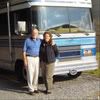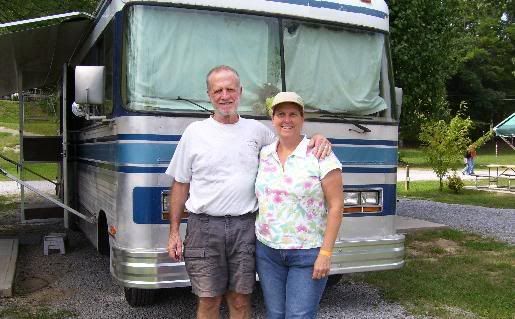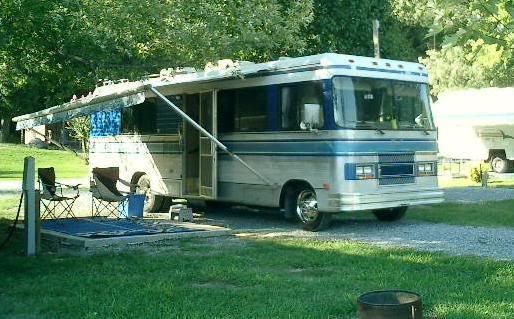Go to...  | Start A New Topic  | Search  | Notify  | Tools  | Reply To This Topic  |  |
 3/23 3/23 |
I designed a 2 cu ft refrigerator while at Norcold that froze everything even in pilot mode, unless the door was opened a lot or warm stuff added. If I were as smart then as I am now I would have thinned out the insulation, saved money for Norcold and given the buyer more space. 1971 24 ft Barth Continental P30 chassis 350 engine | |||
|
 3/23 3/23 |
SteveVW I am curious, I see you have the 3 slot fridge vent I designed for Norcold on your coach, Dometic used a 2 slot one, do you have a Norcold fridge? I was under the impression Barth used only Dometic, Perhaps Jerry Wannamaker was pissed enough getting fired from Dometic he made the change when Barth hired him. Earlier models at the GTG have Dometic vents. 1971 24 ft Barth Continental P30 chassis 350 engine | |||
|
I just measured my AC load from the refrigerator, it draws 300 watts. Considering efficiency losses that would be about 30 amp load on the 12VDC system. Certainly this would require a BIG battery bank to support for any length of time. I can go 2 days using AC for the refer but I have 6 golf cart batteries. Ed 94 30' Breakaway #3864 30-BS-6B side entry New Cummins 5.9L, 375+ HP Allison 6 speed Spartan chassis K9DVC Tankless water heater | ||||
|
 3/23 3/23 |
Ok Fans in the absorption fridge. With the door closed the only source of heat gain is from the door, and walls. so if a fan is moving air about inside the unit, any heat exchange on the walls is always at the same delta T, therefore the heat gain is always the same. Without the fan there is a marginal barrier of warmer air at the wall surface and perhaps a very slow moving air mass. This might allow for less heat exchange or gain, a good thing. But the rub is a fan also does the same thing to the heat exchanger, perhaps making the exchanger more efficient. This allows the cooling system to work harder, and create more heat absorption. So you might get a cooler fridge but it also will cost you more energy. My guess is the burning of more energy, exceeds the insulation heat gain, thus a cooler fridge. 1971 24 ft Barth Continental P30 chassis 350 engine | |||
|
 8/19 8/19 |
| |||
|
 3/23 3/23 |
The run time at 300 watts is probably only 30%+/- | |||
|
 3/23 3/23 |
Just an after thought on refrigerator circulation fans, they are also a heat source so keep the energy they need to a minimum. Eight cubic foot units are really pushing the limit in a 90F ambient to maintain below 40F from just the insulation heat gain. 1971 24 ft Barth Continental P30 chassis 350 engine | |||
|
 6/12 6/12Formally known as "Humbojb"  |
Well, what about junking the absorption unit and getting a compressor unit? My 74 Class C has a refrigerator that runs on AC or DC only, no propane. But, DC operation is a little misleading. When on DC, there is a small inverter in the frig that converts DC to AC to power the frig. Works very well in either mode. Never measured the DC load to power the inverter, but it sure gets cold in either mode. So, the question is, do absorption refrigerators require more energy to operate than compressor style units? Here's a good read www.sundancecustomrv.com/Ammon...%20Refrigerators.pdf
| ||||||||||||
|
 3/23 3/23 |
Nice Article, JIm. Norcold made a smaller AC/DC freon refrigerator, mainly used in boats. I do not know much about the cooling unit as it was made in Japan and all we did was manufacture and install it in a fridge cabinet. I always thought it was just a marginal device. However it did have a very long service life. Before I got my Barth I had an 86 Winne and the absorption Dometic unit went bad, I replaced it with a sears Freon unit with the same size exterior. If I was on the road a long time I would run the generator every once and awhile to keep it cold. worked ok. When I left Norcold in 1995, some of the coach manufacturers were putting side by side regular refrigerators in their larger units specially the 5th wheels. Dometic came out with a two absorption unit side by side, not sure how long that lasted. As folks have sated earlier 300 watts are about what an absorption unit uses, my kitchen fridge uses close to 1000 watts when running. 1971 24 ft Barth Continental P30 chassis 350 engine | |||
|
 8/19 8/19 |
Absorption refrigerators have less moving parts and use less energy. A quote from the link you posted says "the ammonia absorption refrigerator has much better energy efficiency over a compressor driven system." Here is the catch, if you are thinking of "efficiency" as getting cold fast, OR energy consumption. Jim, your dad prolly told you to close the door on the "ice box" so you do not melt the ice. No moving parts = less energy consumed. Manufacturers used to build "gas refrigerators" for home use. The vent pipes caught fire because critters found a nice warm place to nest. Gas or Absorption refrigerators "consume" the least energy. Absorption Refrigerators are not "efficient" at cooling your hot leftover soup. The recovery time after you open the door and let the cold out is not fast either. Like the title above we have need clarification on what you want to be efficient. | |||
|
 3/23 3/23 |
Kevin makes a good point, because of the low BTU output of an absorption unit about 90 BTU, in a high ambient condition or considerable usage (cooling stuff or open door time) they are running using power almost constantly. Probably more or equal power than similar usage in a Freon unit. The AC/DC unit has even less BTU output so it is only used in smaller refrigerators. The compressor needs a sine wave to pump, that's the reason the D/C is converted. They really do not use much power at all about 1 amp on 110 volt current. 1971 24 ft Barth Continental P30 chassis 350 engine | |||
|
| Powered by Social Strata | Page 1 2 3 |
| Please Wait. Your request is being processed... |
|
This website is dedicated to the Barth Custom Coach, their owners and those who admire this American made, quality crafted, motor coach.
We are committed to the history, preservation and restoration of the Barth Custom Coach.
We are committed to the history, preservation and restoration of the Barth Custom Coach.

